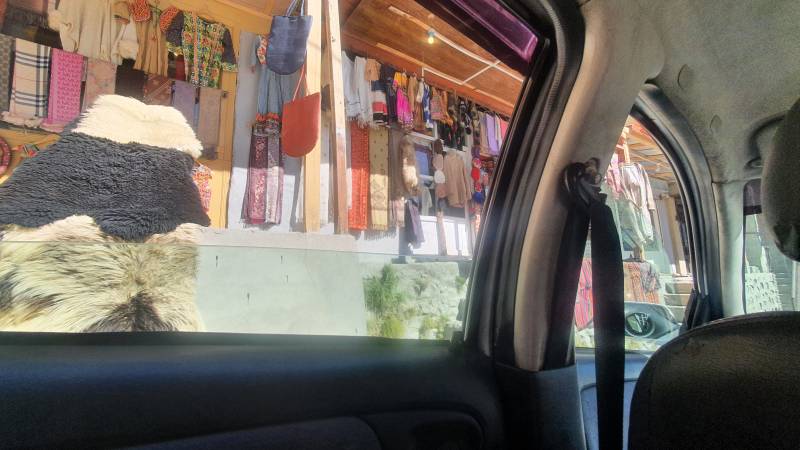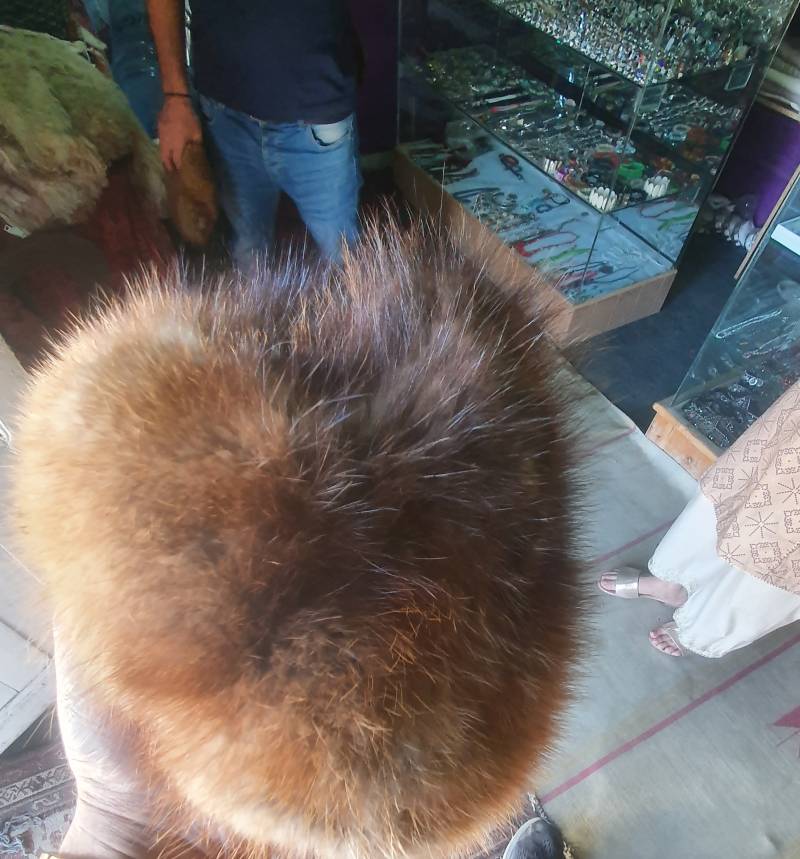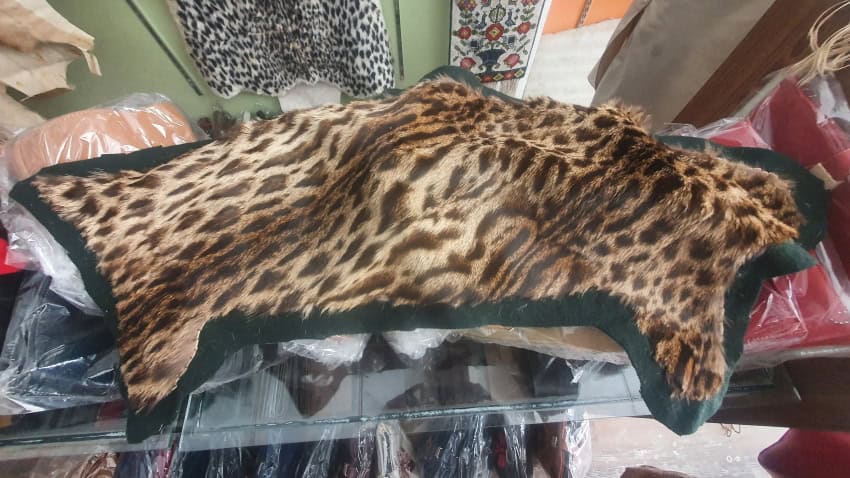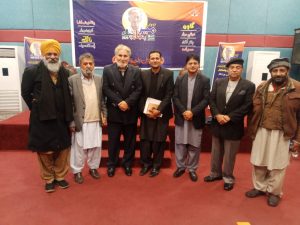Report by Daily Pakistan
Hunza, the crown jewel of Gilgit Baltistan is renowned for its wildlife, landscape, culture, and organic food. Every year, millions of tourists both domestic and foreign visit Gilgit Baltistan particularly Hunza. As the region is home to unique carnivorous and ungulate species, such as the snow leopard, leopard cat, lynx, Suleiman markhor, and Marco polo sheep among other species, tourists throng the valleys in a bid to see them.
However, not everyone comes with the same intent. There are poachers under the guise of wildlife tourism entering the region. Also, there are people trading the skins of carnivorous species, and that too, illegally.
Surprisingly, this is happening right in the heart of the main tourist attraction of Gilgit Baltistan – Hunza.
The investigation by Daily Pakistan has revealed that in Karimabad valley of Hunza, some of the shops selling shawls and cultural artifacts are openly selling the skins of leopard cat, red fox, and mink; and caps and jackets made from the fur of Himalayan wolf and red fox. One vendor had up to five skins of the leopard cat.

Surprisingly, the vendor selling the skins of the leopard cat was selling them as snow leopard skins, as it can fetch him a higher price and ordinary tourists wouldn’t be able to identify that it’s a leopard cat’s skin.
The caps made from the fur of the Himalayan wolf, pelts of mink and red fox, and leopard cat’s skin were being sold at low prices.
The investigating team went to these markets disguised as tourists and sought permission from the vendors to take pictures of the skins. When the pictures were shown to the experts from the Wildlife Department of Gilgit Baltistan and Karakoram International University (KIU), it was revealed that these were not snow leopard skins.

Dr Saeed Abbas, an Assistant Professor from the Animal Sciences Department of Karakoram International University (KIU), Gilgit, is one of the experts to cross-examine the pictures and he dismissed that these were snow leopard skins. “These could be the hides of the leopard cat but since the species is rare in Gilgit Baltistan and henceforth difficult to hunt, it is possible that it might have been hunted outside of Pakistan and smuggled here for sale.”

Looking at the pictures of the wolf caps, Dr Abbas says that the fur is of the Himalayan wolf found in Gilgit Baltistan, as they have fragmented populations in some of the areas of GB but are hunted extensively in Gilgit, Diamer, and Astore districts for predating on livestock.
“In my village in SAS valley, in District Nagar, wolves have disappeared due to illegal hunting,” he adds. On the pictures of the red fox, Dr Abbas says that the species is found in Gilgit Baltistan and is killed for attacking poultry.
When the shopkeeper was asked that whether the snow leopards (which were actually leopard cats) were hunted in Gilgit Baltistan for their skin or were they brought from outside of Pakistan, he told that they were brought through the Wakhan Corridor – a narrow strip of territory in Afghanistan, extending to China and separating Tajikistan from Pakistan.
For centuries, traders from Hunza valley and the Wakhi tribe (Afghanistan) have engaged in barter trade at Wakhan Corridor, which continues to date. The possibility of wildlife trafficking through Wakhan Corridor demands further investigation.
Dr Ali Nawaz, Director, Snow Leopard Foundation (SLF) Pakistan also agrees that the illegal wildlife trade of snow leopard and other species is taking place through the Wakhan Corridor, but up to a certain extent only.
He also told that snow leopard poaching incidents are taking place in Gilgit Baltistan and parts of Khyber Pakhtunkhwa, but they have been reduced due to tough laws by the provincial wildlife departments.
He informed that they had conducted a detailed survey on the illegal hunting and trade of snow leopard in 2017. According to Dr Ali Nawaz, “The survey team disguised as potential buyers went to the markets of Gilgit, Peshawar, Islamabad, Lahore, and Karachi.
“We concluded that from 2007-17, at least 50 snow leopards have been poached in Pakistan, which was killed by shooting, poisoning, and snares.”
More recent figures on the illegal trade of this elusive and shy cat in the region are not available.
Nawaz informs that hunters sell the snow leopard pelts to traders for a meager amount, signaling that the trader or middleman gets the real profit.

The draft wildlife act 2021 and the previous 1975 wildlife act categorically state that it is illegal to bring wildlife into Pakistan without the certificate of lawful possession. Even if wildlife has died a natural death or encountered any incident, its possession belongs to the government.
Dr Saeed Abbas believes that illegal trade is going on unabated in Gilgit Baltistan and the hides of snow leopard and other carnivores, and ungulates (large mammals with hooves) are being sold to tourists.
“I got to know of this when I was working with World Wide Fund for Nature-Pakistan (WWF-Pakistan) on a survey to investigate illegal wildlife trade in Pakistan. The survey recorded the use of derivatives of 12 mammals – snow leopard, Indian pangolin, common leopard, black bear, and brown bear, five reptiles – marine and freshwater turtles, spiny-tailed lizards and snakes, etc., two birds – Peregrine and saker falcon, and many invertebrate species are being sold by street vendors and local herbalists (hakeem).
A total of 14 social media groups out of 24, and 14 Facebook pages out of 130 assessed, were found to be involved in the illegal sale of wildlife in Pakistan. As we were disguised as potential buyers to seek information for the survey, the traders from Gilgit told us that they can get us the skins of the snow leopard, Himalayan brown bear, and Himalayan wolf, if we are interested.”
“This can be re-confirmed from the fact that when a male brown bear was killed in Kilishai area of Minimarg valley in Astore district, Gilgit Baltistan in 2019, its genitals were chopped off. This was not retaliatory killing but the bear was hunted for its genitals”, added Dr Abbas.
He also quoted an incident that took place in the Skardu market in the Baltistan region in 2020, where a snow leopard skin was found but the wildlife department couldn’t reach out to the actual culprit. “The District Forest Officer (DFO), Muhammad Akram said that it’s old skin.”
In 2018, a separate incident took place in Misgar valley of Hunza, Gilgit Baltistan, where a snow leopard was killed in retaliation to the loss of livestock by locals, its body was found without the skin. Such incidences reveal that even in the case of human-snow leopard conflict, the snow leopard is not just killed but its skin is also peeled off to be sold in the market.
“Sadly, the poaching of the snow leopard is taking place in Gilgit Baltistan but is not being reported. Before recent past, the focus of the Forest’s, Parks, Wildlife and Environment Department, Gilgit Baltistan was mainly on the trophy hunting of markhor, ibex, and other ungulates, but since the last two or three years the department has started working on the conservation of other key species like snow leopard, wolf, etc,” remarked Dr Abbas of KIU.
But the Forest, Parks, Wildlife, and Environment Department, Gilgit Baltistan hold a different view. While meeting Ijlal Ahmed, Conservator Wildlife, Forest’s, Parks, Wildlife and Environment Department, Gilgit Baltistan, he reiterated that illegal hunting of snow leopard is not taking place in Gilgit Baltistan.
As a matter of fact, Ahmed believes that the population of snow leopards has increased. “There are estimated 150-200 snow leopards in Gilgit Baltistan and we have enacted strict laws to reduce illegal hunting. Last year in October, when a female snow leopard was hunted in Hopper valley, in Nagar, Gilgit Baltistan, the hunter was jailed for six months and was fined Rs.0.5 million. The matter is still in court.”
To further reduce the demand for snow leopard trophies, Ahmed informed that the Forest, Parks, Wildlife, and Environment Department is planning to develop artificial snow leopard trophies, which will help reduce poaching.
Dr Zafar Khan, Chairman of the Department of Forestry, Range and Wildlife Management at Karakoram International University (KIU), Gilgit, is of the view that the possibility of illegal hunting of snow leopard cannot be ruled out. “This is a sensitive matter, as people in Gilgit Baltistan are concerned about wildlife and environment.”
He adds, “However retaliatory killing and carcass poisoning happens, and to a lesser extent illegal trade of snow leopard skins and its body parts.”
Ashiq Ahmed Khan, a senior wildlife expert, categorically denies any organized racket of snow leopard hunters operating within Gilgit Baltistan. “The illegal hunting of snow leopard and trade of its body parts is next to none. Hardly five snow leopards might be hunted in a given year, which is documented. Other than that, it is not documented.”
“At times, the wildlife watchers get to know about it and also report to the department and at times they do not even report it,” adds Khan.
Ashiq Ahmed Khan further shares that more than 95% of hunting of snow leopard is actually retaliatory killing. According to him, “The bakarwals kill the snow leopard in retaliation to the loss of livestock and such incidences usually occur on high pastures. It is nearly impossible to trace such incidences unless the wildlife watcher is present at the crime spot, otherwise, scavengers such as the Himalayan vulture, Bearded vulture, Magpie, and Alpine chough consume the snow leopard carcass. The nomads don’t sell the snow leopard skin in Gilgit and other cities for the fear of getting caught. The issue of retaliatory killing of snow leopards by bakarwals has neither been investigated nor documented.”

Photo credits: Forest, Parks, Wildlife, and Environment Department, Gilgit Baltistan.
“The bone trade of snow leopard is rare, as its consumption in Pakistan has not been reported. However, it is possible that the snow leopard bones are being smuggled to China through the Karakoram Highway (KKH), which needs to be investigated,” adds Khan.
Dr Ali Nawaz of SLF Pakistan also agrees with Ashiq Ahmed Khan that the possibility of smuggling snow leopard skin and bones to China cannot be ruled out.
However, the fear of being fined and imprisoned by the Forest, Parks, Wildlife, and Environment Department of Gilgit Baltistan has discouraged poachers and bakarwals from snow leopard poaching.
It is inhumane and barbaric to kill wildlife, just so to meet the requirements of a specific class and those involved in wildlife crime should be dealt with according to law. The department should protect wildlife besides trophy animals. They need to prioritize the issue of illegal wildlife trade and should conduct an undercover survey so that wildlife trafficking could be stopped.
On the other hand, the concerns of the local communities should be addressed, as when the snow leopard and other carnivores prey on livestock, it seriously affects their livelihoods. The communities should be rightly compensated for the losses incurred to end the retaliatory killings of snow leopards.
This investigation is part of a series on the illegal trade of snow leopards, supported by Oxpeckers Investigative Environmental Journalism and the Global Initiative Against Transnational Organised Crime.
Pictures: Daily Pakistan Reporting Team.













